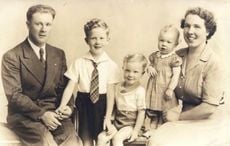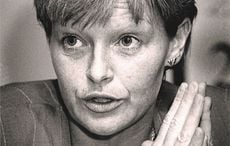The apparent suicide of Alexander McQueen (Lee McQueen), was committed it is widely reported in response to the death of his mother. He was a a 21st century romantic who explored the sinister that lurks beneath the traditional costumes of the gentleman and lady. He was futuristic and a dark revisionist of the entire canon of English fashion.
He was a rebel who invoked his Scottish heritage from the very beginning of his career and throughout, using traditional Gaelic materials such as tartan, lace and tweed. He also famously insulted the pretender to the throne of Wales.
Alexander McQueen was born the youngest of six children on March 17th 1969 in London to a working class family. His father was a hackney driver. His mother Joyce a teacher. When he was 16, he was watching a television program about the declining number of traditional tailor apprentices, quit school, and became a master of the trade. In time he would be christened "the hooligan of English fashion."
While learning his trade on Saville Road, McQueen was elevated to a position where he would tailor clothing for members of the inbred royal class. In an interview McQueen proudly described how he once stitched 'I am a c*nt' into the suit sleeve lining of one of Prince Charles' suits he had created.
When McQueen broke out to become his own man, he introduced his first collection in the Fall 1995 season with a fashion lexicon that included plaid and tweed from his family’s Scottish heritage. He called it the Highland Rape collection.
The show was in London, and introduced his raw and aggressive vision as a kind of nightmare, replete with lace, tartan and plaid. (There were rumors that the fabric had been stolen, but that was all part of the myth that surrounded the legend). The runway for the show was transformed into a Scottish moor, and the clothes were modeled by models described at the time as deranged, who staggered recklessly down the moor as if possessed by demons. The show took place very far from the usual haughty marquees of London's Fashion Week, at a warehouse on the outskirts of town.
The show explicitly explored the relationship between Scotland and England, and between people from his family's class and that of the "royal" family he designed for when he began his career on Saville Road.
He revisited the Scottish theme in the Fall 2006 shows in Paris. For this collection, refined the contents of "Highland Rape." The raw demonic energy was replaced by poetic invocations of Scotland. Technically accomplished, the pieces invoked Scottish fantasy with romantic images of heroines, of the awe-inspiring landscape and castle. He presented tartan crinolines, headdresses made from antlers and bird wings. Some gowns were feathered, others made with brocades, or black velvet. He conjured Lady Macbeth, with bell-skirted plaid dresses and lace sleeves, punked out to modernize and revise all traditions.
Speaking of his ethos, Alexander McQueen said "The clothes I design are strong - they are meant to build confidence".
In June 2003 he was awarded international Designer of the Year by The Council of Fashion Designer's of America (CFDA) and in the same month queen Elizabeth "Windsor" gave him a medal with the words "British Empire" on it, and like Scottish National Party member Seán Connery, he wore the highlander's rebel warrior outfit to the ceremony. David Bowie went better, and refused the defunct (the empire was defeated, and no longer exists) honor/chattle-branding.
His death at age 40 left a legacy of futuristic visions. His last collection invoked James Cameron's Avatar last spring, summoning many of the Highland Rape themes. He presented colonization through images of monsters and demons to keep the emotional effect of history and innovation violent and subconscious.
The runway show for his next McQ collection was scheduled for Thursday night in New York, and has been canceled.




Comments